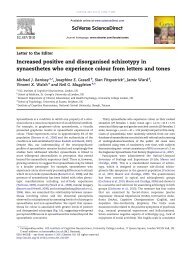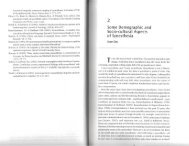A strong parietal hub in the small-world - Synesthesia
A strong parietal hub in the small-world - Synesthesia
A strong parietal hub in the small-world - Synesthesia
You also want an ePaper? Increase the reach of your titles
YUMPU automatically turns print PDFs into web optimized ePapers that Google loves.
Small-<strong>world</strong> network of coloured-hear<strong>in</strong>g synaes<strong>the</strong>tes 181<br />
In <strong>the</strong> present study, we readdress <strong>the</strong> issue whe<strong>the</strong>r <strong>small</strong>-<strong>world</strong> network characteristics<br />
are related to <strong>in</strong>ter-<strong>in</strong>dividual differences <strong>in</strong> cognition. Here, we exam<strong>in</strong>e<br />
whe<strong>the</strong>r coloured-hear<strong>in</strong>g synaes<strong>the</strong>tes demonstrate different <strong>small</strong>-<strong>world</strong> network<br />
characteristics compared with non-synaes<strong>the</strong>tes by us<strong>in</strong>g rest<strong>in</strong>g state EEG <strong>in</strong> association<br />
with a valid method, to estimate <strong>the</strong> <strong>in</strong>tra-cerebral sources of surface EEG (standardized<br />
low-resolution electrical tomography [sLORETA]) (Pascual-Marqui, 2002). Based on <strong>the</strong><br />
two-stage model proposed by Hubbard (2007), we hypo<strong>the</strong>size that synaes<strong>the</strong>tes should<br />
have a <strong>strong</strong> network <strong>hub</strong> <strong>in</strong> <strong>the</strong> <strong>parietal</strong> lobule subserv<strong>in</strong>g hyperb<strong>in</strong>d<strong>in</strong>g and o<strong>the</strong>r<br />
<strong>strong</strong> <strong>hub</strong>s <strong>in</strong> <strong>the</strong> fusiform gyrus (process<strong>in</strong>g colour) and <strong>the</strong> auditory cortex (process<strong>in</strong>g<br />
tones). We are particularly <strong>in</strong>terested <strong>in</strong> <strong>the</strong> <strong>in</strong>terconnectedness of <strong>the</strong>se <strong>hub</strong>s, which<br />
can be expressed <strong>in</strong> specific measures proposed by <strong>the</strong> graph-<strong>the</strong>oretical analysis. In this<br />
study, we will use degree as a particular measure of local <strong>in</strong>terconnectedness. Therefore,<br />
this measure should be <strong>strong</strong>er for coloured-hear<strong>in</strong>g synaes<strong>the</strong>tes <strong>in</strong> <strong>the</strong> hypo<strong>the</strong>sized<br />
regions.<br />
In this study, we focus on <strong>the</strong> so-called rest<strong>in</strong>g EEG and its relation to colouredhear<strong>in</strong>g<br />
synaes<strong>the</strong>sia. Rest<strong>in</strong>g EEG is <strong>the</strong> tonic EEG activation pattern of subjects <strong>in</strong> a<br />
relaxed state dur<strong>in</strong>g that <strong>the</strong>y are not execut<strong>in</strong>g a particular psychological task. The<br />
<strong>in</strong>tra-<strong>in</strong>dividual stability of rest<strong>in</strong>g EEG measures has been demonstrated repeatedly for<br />
different frequency bands (Näpfl<strong>in</strong>, Wildi, & Sarn<strong>the</strong><strong>in</strong>, 2007). In addition, rest<strong>in</strong>g EEG is<br />
<strong>strong</strong>ly determ<strong>in</strong>ed by genetic factors (Ambrosius et al., 2008; Anokh<strong>in</strong>, Lutzenberger,<br />
& Birbaumer, 1999; Ivon<strong>in</strong>, Tsitserosh<strong>in</strong>, Pogosyan, & Shuvaev, 2004; L<strong>in</strong>kenkaer-<br />
Hansen et al., 2007; Orekhova, Stroganova, Posikera, & Malykh, 2003; Posthuma, Neale,<br />
Boomsma, & de Geus, 2001; Smit, Wright, Hansell, Geffen, & Mart<strong>in</strong>, 2006; Tang et al.,<br />
2007). Thus, rest<strong>in</strong>g EEG can be taken as a stable biological marker for <strong>in</strong>dividual bra<strong>in</strong><br />
activity.<br />
Methods<br />
Subjects<br />
The analysis and this paper are based on <strong>the</strong> data obta<strong>in</strong>ed <strong>in</strong> <strong>the</strong> context of a study<br />
published <strong>in</strong> Beeli et al. (2008). Thus, we will only shortly describe <strong>the</strong> <strong>in</strong>cluded subjects<br />
and <strong>the</strong> methods to confirm <strong>the</strong> presence of synaes<strong>the</strong>sia. In this study, we report data<br />
from 12 synaes<strong>the</strong>tes and 13 non-synaes<strong>the</strong>tes matched for sex, education, and age<br />
(mean age ± standard deviation: synaes<strong>the</strong>tes 25.7 ± 9.1, controls 26.1 ± 6.4; mean<br />
years of education: synaes<strong>the</strong>tes 15.3 ± 1.8, controls 14.3 ± 0.9; groups did not differ<br />
significantly: p = .88 for age, and p = .13 for education). All synaes<strong>the</strong>tes reported lifelong<br />
history of ‘color-hear<strong>in</strong>g’ synaes<strong>the</strong>sia and <strong>the</strong>y were tested for <strong>the</strong>ir colour perception<br />
to letters (A–Z) and numbers (0–9). They were asked to produce <strong>the</strong>ir synaes<strong>the</strong>tic<br />
colours elicited by auditorily presented letters and digits as accurately as possible us<strong>in</strong>g a<br />
digital image-edit<strong>in</strong>g software (Adobe Photoshop 7.0). All synaes<strong>the</strong>tes had to repeat this<br />
task (on average 55 days later), and all of <strong>the</strong>m demonstrated constant and consistent<br />
reproduction. None of <strong>the</strong> synaes<strong>the</strong>tes reported to experience additional synaes<strong>the</strong>tic<br />
experiences over and above <strong>the</strong> reported and verified coloured-hear<strong>in</strong>g synaes<strong>the</strong>sia.<br />
EEG record<strong>in</strong>g and process<strong>in</strong>g<br />
Rest<strong>in</strong>g EEG was recorded us<strong>in</strong>g a 30 channel EEG montage accord<strong>in</strong>g to <strong>the</strong> 10–10<br />
system (Fp1/2, F3/4, F7/8, Fz, FT7/8, FC3/4, FCz, T7/8, C3/4, Cz, TP7/8, CP3/4, CPz,<br />
P7/8, P3/4, Pz, O1/2, Oz) with <strong>the</strong> Bra<strong>in</strong>Amp system of Bra<strong>in</strong>Products, Munich, Germany.




